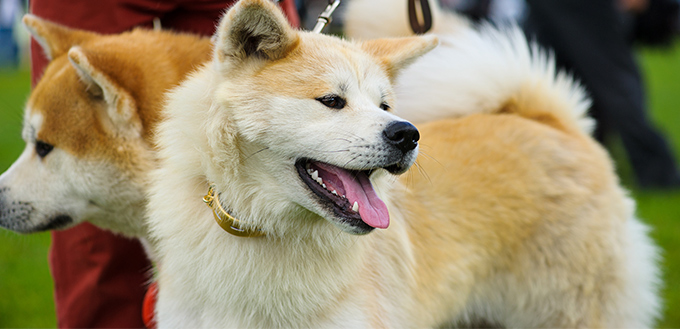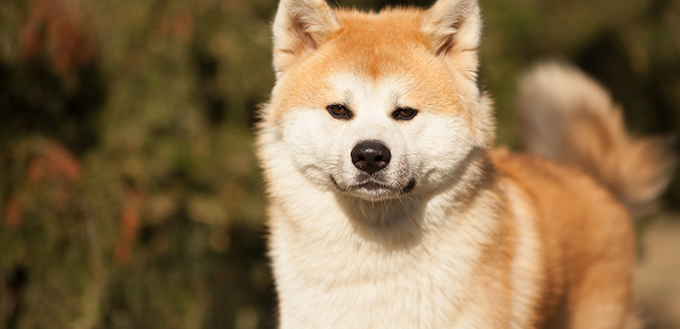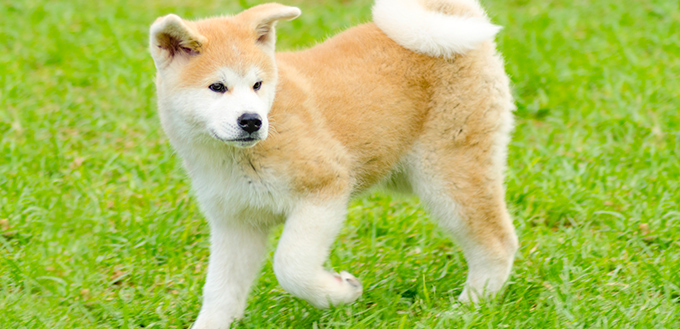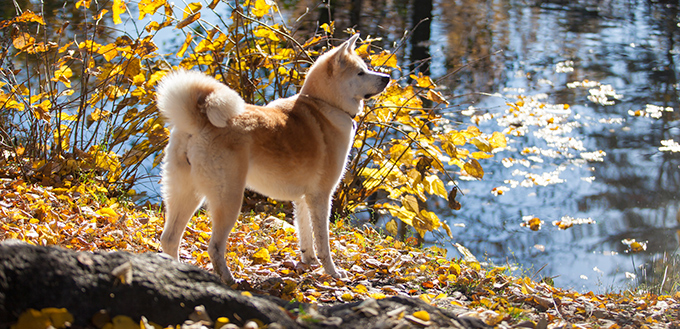Adding a new member to the family is a big decision. You can’t just get a new dog on a whim and hope for the best. After all, dogs are a huge responsibility, and you must make sure that your new dog is going to fit into your family’s lifestyle. Akita dogs are big, strong, protective, and independent, and this will have an impact on your family. Do you want a protective dog or a cuddle companion? Do you have the experience and time for training, or are you looking for a dog that is easy to manage? There are many things you need to consider before getting your Akita dog, but, luckily, we are here to help.

History of the Akita Dog
As an internationally renowned breed, the Akita dog has a fascinating history, which spans both its native Japan and the United States. As with all dogs, understanding a breed’s history, and what they were bred for, is the best starting place for understanding their temperament today.
The Akita Dog in Japan
The history of the Akita dog begins in its home country of Japan. Predecessors to the Akita dog have been recorded since 1150 AD, and they were bred for hunting and fishing. As well as being used to herd animals and fish into traps, their fur made for warm clothing to protect against long, cold winters.
Akita dogs even have their own origin myth. According to legend, the Akita dog was bred on the orders of a disgraced nobleman who wanted the perfect hunting dog to use for hunting in the cold, northern province he was banished to. After many generations of dog competed for his approval, success was finally found in the Akita dog that could even hunt bears.
Over time, their loyalty, strength, beauty, and skill at hunting caught the attention of a number of Japanese rulers, and there have been moments in history when only royalty could own, raise and train them. These dogs would have their own staff to ceremoniously feed them, and special collars that denoted their prestige.
This brings us to the 20th century when the breed’s popularity spread from royalty in Japan to royals, aristocracy and other important people throughout the world, such as in the UK, France and Spain. It was during this time that Japanese officials made an effort to record Akita dog offspring.
The Akita Inu Hozankai Society started a stud book, which still exists today, in 1927, and the dogs were designated a national treasure in 1931 after being given pure breed status. As the Mayor of Odate, which is within the northern Akita prefecture, gave the dog it’s pure breed status, this is the origin of its name.
Related Post: Best Food for Hunting Dogs
The Akita Dog in America
The first registered Akita dog in the United States was owned by a military officer in Montana, but they were not popularized until 1937 when Helen Keller, the deaf-blind activist and author, was sent one named ‘Kamikaze’, which was shortened to ‘Kami’. Unfortunately, this puppy passed away, but she was given another named ‘Kenzan-go’, who stayed with her until 1945.
After the war, the USA’s love of Akita dogs really took off, and this led to variations in the breeds. While Japanese breeders have continued to breed Akita dogs to be sleek, American breeders have bred their Akitas to become larger and heavier. If you have any physical or aesthetic preferences, remember to ask a breeder for either a Japanese or American variety.
Quick Facts
Just as people are more than their past, dogs are also more than their history. Although a breed is often bred for a specific purpose, they also end up with many unplanned traits that can make them ideal, or difficult, pets. To help you better understanding this gorgeous, honorable and iconic animal, here are some fun little facts about them:
- The average lifespan of the Akita dog is 10 to 11 years old.
- The Akita dog is a spitz-type dog. It originated from a similar northern arctic lineage as the Siberian Husky, and they are characterized by their thick, usually white, fur, pointed ears and curled tails.
- The Japanese Akita dog is usually called the Akita Inu as ‘Inu’ means dog in Japanese.
- Adult male American Akitas tend to be 66 to 71 cm and weigh up to 56 kg, while Akita Inu tends to be 64 to 70 cms and weigh up to 39kg.
- Adult female American Akitas tend to be 61 to 66 cm and weight up to 66 kg, while Akita Inu tends to be 58 to 64 cm and weigh up to 65 kg.
- As part of the Akita dog’s role as a national symbol, babies in Japan are often gifted with Akita dog figurines to bestow happiness and longevity.
- The most famous dog in Japan is an Akita dog named Hachiko. Hachiko would wait for his owner after work every day outside Shibuya station. After his owner’s unexpected death, Hachiko continued to make this daily journey for nine years, making him a Japanese symbol of loyalty.
- You can visit a museum in Odate which is dedicated to the Akita dog.
- Akitas have webbed toes which make them adept at moving on snow.
- Most Akita dogs are very clean and usually smell better than your average dog.
- One of President Putin’s four dogs that live with him in Moscow is an Akita dog called Yume that was given to him by the Akita prefecture in Japan following Russia’s assistance during an earthquake and tsunami in 2011.

Things You Should Know
Using the essential facts and history of the breed, we’ve now established that Akita dogs were bred as working companions for royalty, and this has made them strong, intelligent, caring, and beautiful. This definitely can make for a fantastic pet, but before you make your decision, you should learn about what life is like living with an Akita dog.
Training
Akitas are a very intelligent breed, and, as with all intelligent breeds, this means they can be trained. Intelligent dogs will pick up instructions and cue words, and will probably even enjoy the challenge as clever dogs can also often struggle with boredom. However, Akita training is a serious matter because of their history as hunting dogs. Considerations you must have when training an Akita puppy include:
- Training must begin as early as possible
All dogs benefit from early socialization and early training, but with the Akita dog, it is essential. A good breeder will start this process before selling any Akita puppies, so you should enquire about their socialization before you buy them. Once you have your Akita puppy, you should begin training them as soon as they are home.
While other, more cautious, dogs may need some time to adjust, the confident Akita dog requires immediate work and training. You cannot avoid training them, and you start by enforcing ground rules, boundaries, ‘leave it’ commands, and ‘recall’ commands. After this, you must also train them to respond to ‘down’, ‘stop’, ‘quiet’, ‘sit’, and ‘stay’, or any of your preferred variants.
- Akita dogs are a dominant breed, so seek advice from a professional and have plenty of experience
Training an Akita dog must be firm so that they learn their place in the household, or pack. Otherwise, their instinct is to see themselves as the leader and they will become unmanageable. They are stubborn dogs and that makes them relatively difficult to train when compared with other intelligent breeds.
This means that you must have dog training experience if you want to adopt an Akita dog, and may still need to seek advice from a professional behaviorist. You will need to work closely with this behaviorist, however, and cannot simply rely on them to do all the work. This is because you, not someone outside the household, must be their pack leader. If you do not have experience with training a bossy dog, an Akita dog may not be for you.
- You should only use positive reinforcement
As Akita dogs are so dominant, it is easy to think that providing firm training means being harsh or corrective, and using negative reinforcement. As with all dogs, this is a mistake. Dogs do not respond well to negative reinforcement, which is the use of punishment. They are likely to develop anxious or aggressive personalities.
An Akita dog faced with harsh training techniques is likely to respond with aggression, which can create an unpleasant and dangerous environment in your home. Akita dogs are very strong and their history of hunting make them particularly dangerous if they are not properly trained. You should only use positive reinforcement, a system of rewards, to encourage desired behaviors in your Akita dog.
- It is possible to overtrain an Akita dog
Akita dogs have been so well bred as hunting companions that they can, in fact, become over-trained and unsuitable for family life. An Akita dog that has been used as a watch dog, for example, will be naturally too aggressive and paranoid to provide any companionship. This is also why you may want to learn the full history of any adult Akita dog that you may be considering adopting. To adopt an adult Akita, you will need a lot of training experience, preferably with other Akita dogs.
Frankly, no Akita dog should be trained as a watch dog. Security services and police prefer using other breeds, and no private household needs an Akita dog that is trained to that level, particularly around children and guests. Due to their protective natures, a normally trained Akita will already naturally act as a guard dog around the house, so it is more important to temper this urge to protect in your Akita to prevent aggression.
Feeding
As mentioned below, one of the health concerns that can affect Akita dogs is bloating. As such, you should not feed an Akita dog large meals. They need to have at least two smaller meals, given to them in the morning and evening. It is crucial that you provide an Akita dog with routine and do not regularly change their feed. This is both because structure makes them happy, but also because they will suffer from stomach problems.
Akitas are not fussy, but they do need a high quality food if you want their health and coats to remain at a high standard. The amount that you should feed an adult Akita depends on their weight. A general guide for feeding an Akita dog is:
- Up to 422g a day if they weigh 32kg
- Up to 566g a day if they weigh 50kg
- Up to 608g a day if they weigh 66kg
Akita dogs can be considered adults at 15 months old. Before they turn 15, however, Akita puppies need to be fed portions that support their growth. They need the most food at around 6 to 7 months old. Portions must also be determined by their build. Examples of Akita puppy portions include:
- Up to 307g a day for a 2 month old
- Up to 599g a day for a 6 month old
- Up to 520g a day for a 10 month old
- Up to 395g a day for a 14 month old
The best thing to do is to ask the advice of the breeder who had been caring for them. They will advise you about what they have been eating and what to switch to as they grow.

Grooming
One of an Akita dog’s finest features is their beautiful coats, and they are naturally very clean animals. While they are often white, like many other spitz-type dogs, they can come in a wide variety of colors, such as fawn or black. Grooming these coats is essential, and you must be prepared for plenty of shedding.
Shedding occurs mostly in Spring, but often also in Autumn. During this time, hair may come out in clumps, which might be alarming, but is completely normal. General rules for grooming your Akita dog include:
- You should brush an Akita dog once a day during shedding seasons
- Outside of shedding seasons, you can get away with brushing most Akita dogs once a week
- You should also use these sessions to check and clip their nails
- Puppies must be trained to be enjoy being touched from a very early age
- You should get a professional groomer for your Akita dog around three times a year
- Bathing should also be done around three times a year, and, as an Akita’s coat is quite resistant to being made wet, it is advised that you get a professional to do this as well.
Health
Akita dogs are generally quite healthy dogs. With a good diet and plenty of exercise, your Akita dog should live for around a decade. However, all dogs have their health risks and Akita dogs are more predisposed to struggle with certain disorders and can be sensitive to certain drugs. Health issues to look out for include:
- Autoimmune Hypothyroiditis, in which a dog’s immune system attacks their thyroid gland
- Vestibular Syndrome, which will affect their balance as their vestibular system is compromised
- Von Willebrand’s Disease, which is a blood clotting disorder comparable to hemophilia
- Luxating Patella, a hereditary knee condition
- Hip Dysplasia, a hereditary hip condition
- Mycrocytosis, a blood disorder
- Akita thyroid, which can cause skin issues
- Summer Stress due to their thick fur and summer heat
- Bloating
As many of these health issues can be hereditary, you must be aware of them if you are planning to breed any Akita dogs. There are tests you can do on your stud dog to make sure they will not pass on any of these health issues to a their litter.
Akita dogs can also struggle with some medication and drugs. They can have a particularly notable issue with anesthesia and sedatives. Other medications that may cause a negative reaction include travel-sickness pills. It is always worthwhile to remind your vet of these sensitivities before undertaking any procedure.
In terms of exercise, an Akita dog needs both physical and mental exercise every day. You should take an Akita for two separate one-hour walks, and give them space to run and play without their leads. As hunting dogs, however, they should not be let off their leads near to other animals. Gardens are great for Akita dogs, but they enjoy escaping so make sure they are dog-proof.
Temperament
As you’ve probably surmised, Akita dogs are not for first time dog owners. Adopting an adult Akita in particular must only be done by experienced Akita owners. This is because of the challenges that come with their temperament.
They have a strong prey drive and are very protective. This means that their natural urge can be to defend the home, even against your friends or your children’s friends, or to attack and chase other animals when outside. Their dominant personality will overpower you if you are not prepared to deal with it, and they quickly pick up bad habits.

This is not to suggest that Akita dogs do not have a lovely temperament when they are provided with the structure, training, and support that they deserve. They are loyal, patient, playful, and clean members of the family. They usually don’t mind being touched by family members, and their gorgeous coats make for the most amazing cuddles.






